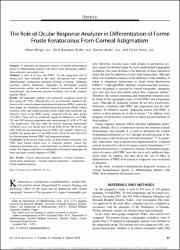| dc.contributor.author | Kırgız, Ahmet | |
| dc.contributor.author | Karaman Erdur, Sevil | |
| dc.contributor.author | Atalay, Kürşat | |
| dc.contributor.author | Gürez, Ceren | |
| dc.date.accessioned | 10.07.201910:49:13 | |
| dc.date.accessioned | 2019-07-10T19:36:28Z | |
| dc.date.available | 10.07.201910:49:14 | |
| dc.date.available | 2019-07-10T19:36:28Z | |
| dc.date.issued | 2019 | en_US |
| dc.identifier.citation | Kırgız, A., Karaman Erdur, S., Atalay, K. ve Gürez, C. (2019). The role of ocular response analyzer in differentiation of forme fruste keratoconus from corneal astigmatism. Eye and Contact Lens-Science and Clinical Practice, 45(2), 83-87. https://dx.doi.org/10.1097/ICL.0000000000000541 | en_US |
| dc.identifier.issn | 1542-2321 | |
| dc.identifier.issn | 1542-233X | |
| dc.identifier.uri | https://hdl.handle.net/20.500.12511/1171 | |
| dc.identifier.uri | https://dx.doi.org/10.1097/ICL.0000000000000541 | |
| dc.description.abstract | Purpose:To determine the diagnostic accuracy of corneal biomechanical factors in differentiating patients with forme fruste keratoconus (FFKC) from astigmatic and normal cases.Methods:A total of 50 eyes with FFKC, 50 with astigmatism and 50 normal eyes, were included in this study. All patients had a detailed ophthalmologic examination including slit-lamp evaluation, Goldmann tonometry, indirect fundoscopy, topography by Scheimpflug imaging biomicroscopic anterior and posterior segment examination, and corneal biomechanical and intraocular pressure evaluation with ocular response analyzer (ORA).Results:All topographic findings were statistically significant among the three groups (P>0.05). Although there was no statistically significant difference in the corneal-compensated intraocular pressure (IOPcc) among the three groups, the Goldmann-correlated intraocular pressure (IOPg), corneal hysteresis (CH), and corneal resistance factor (CRF) were statistically significantly lower in the FFKC group, compared with the other groups (P<0.001). There were no statistically significant difference in the IOPg, CH, and CRF between astigmatism and control groups (P=0.99, 0.79, and 0.86, respectively). The area under the receiver operating characteristic (AUROC) curve was greater than 0.85 for IOPg (0.80), CH (0.85), and CRF (0.90) for discriminating between FFKC and controls; whereas the AUROC was greater than 0.85 for IOPg (0.80), CH (0.79), and CRF (0.85) for discriminating between FFKC and astigmatism groups.Conclusion:Based on our study results, in differentiation of patients with FFKC from normal control cases or astigmatic patients, corneal biomechanical parameters play a role particularly in patients with suspicious results. We suggest using ORA in combination with corneal topography for better and more accurate diagnosis of FFKC. | en_US |
| dc.language.iso | eng | en_US |
| dc.publisher | Lippincott Williams and Wilkins | en_US |
| dc.rights | info:eu-repo/semantics/openAccess | en_US |
| dc.subject | Anterior Segment Parameters | en_US |
| dc.subject | Astigmatism | en_US |
| dc.subject | Corneal Biomechanical Properties | en_US |
| dc.subject | Corneal Hysteresis | en_US |
| dc.subject | Forme Fruste Keratoconus | en_US |
| dc.subject | Ocular Response Analyzer | en_US |
| dc.title | The role of ocular response analyzer in differentiation of forme fruste keratoconus from corneal astigmatism | en_US |
| dc.type | article | en_US |
| dc.relation.ispartof | Eye and Contact Lens-Science and Clinical Practice | en_US |
| dc.department | İstanbul Medipol Üniversitesi, Tıp Fakültesi, Cerrahi Tıp Bilimleri Bölümü, Göz Hastalıkları Ana Bilim Dalı | en_US |
| dc.authorid | 0000-0001-9829-7268 | en_US |
| dc.identifier.volume | 45 | en_US |
| dc.identifier.issue | 2 | en_US |
| dc.identifier.startpage | 83 | en_US |
| dc.identifier.endpage | 87 | en_US |
| dc.relation.publicationcategory | Makale - Uluslararası Hakemli Dergi - Kurum Öğretim Elemanı | en_US |
| dc.identifier.doi | 10.1097/ICL.0000000000000541 | en_US |
| dc.identifier.wosquality | Q3 | en_US |
| dc.identifier.scopusquality | Q2 | en_US |


















